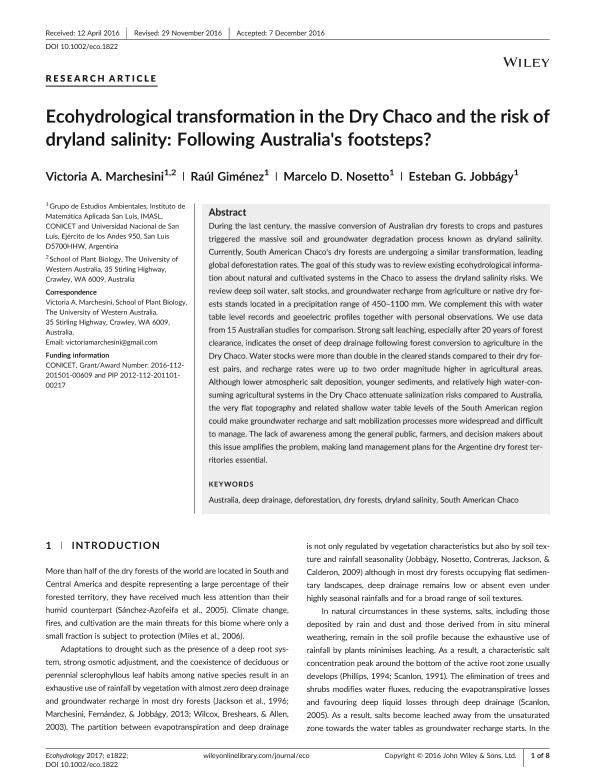Mostrar el registro sencillo del ítem
dc.contributor.author
Marchesini, Victoria Angela

dc.contributor.author
Giménez, Raúl

dc.contributor.author
Nosetto, Marcelo Daniel

dc.contributor.author
Jobbagy Gampel, Esteban Gabriel

dc.date.available
2018-11-27T14:20:37Z
dc.date.issued
2017-06
dc.identifier.citation
Marchesini, Victoria Angela; Giménez, Raúl; Nosetto, Marcelo Daniel; Jobbagy Gampel, Esteban Gabriel; Ecohydrological transformation in the Dry Chaco and the risk of dryland salinity: Following Australia's footsteps?; John Wiley & Sons Inc; Ecohydrology; 10; 4; 6-2017; 1-8
dc.identifier.issn
1936-0584
dc.identifier.uri
http://hdl.handle.net/11336/65288
dc.description.abstract
During the last century, the massive conversion of Australian dry forests to crops and pastures triggered the massive soil and groundwater degradation process known as dryland salinity. Currently, South American Chaco's dry forests are undergoing a similar transformation, leading global deforestation rates. The goal of this study was to review existing ecohydrological information about natural and cultivated systems in the Chaco to assess the dryland salinity risks. We review deep soil water, salt stocks, and groundwater recharge from agriculture or native dry forests stands located in a precipitation range of 450–1100 mm. We complement this with water table level records and geoelectric profiles together with personal observations. We use data from 15 Australian studies for comparison. Strong salt leaching, especially after 20 years of forest clearance, indicates the onset of deep drainage following forest conversion to agriculture in the Dry Chaco. Water stocks were more than double in the cleared stands compared to their dry forest pairs, and recharge rates were up to two order magnitude higher in agricultural areas. Although lower atmospheric salt deposition, younger sediments, and relatively high water-consuming agricultural systems in the Dry Chaco attenuate salinization risks compared to Australia, the very flat topography and related shallow water table levels of the South American region could make groundwater recharge and salt mobilization processes more widespread and difficult to manage. The lack of awareness among the general public, farmers, and decision makers about this issue amplifies the problem, making land management plans for the Argentine dry forest territories essential.
dc.format
application/pdf
dc.language.iso
eng
dc.publisher
John Wiley & Sons Inc

dc.rights
info:eu-repo/semantics/openAccess
dc.rights.uri
https://creativecommons.org/licenses/by-nc-sa/2.5/ar/
dc.subject
Australia
dc.subject
Deep Drainage
dc.subject
Deforestation
dc.subject
Dry Forests
dc.subject
Dryland Salinity
dc.subject
South American Chaco
dc.subject.classification
Oceanografía, Hidrología, Recursos Hídricos

dc.subject.classification
Ciencias de la Tierra y relacionadas con el Medio Ambiente

dc.subject.classification
CIENCIAS NATURALES Y EXACTAS

dc.subject.classification
Ingeniería Medioambiental y Geológica, Geotécnicas

dc.subject.classification
Ingeniería del Medio Ambiente

dc.subject.classification
INGENIERÍAS Y TECNOLOGÍAS

dc.title
Ecohydrological transformation in the Dry Chaco and the risk of dryland salinity: Following Australia's footsteps?
dc.type
info:eu-repo/semantics/article
dc.type
info:ar-repo/semantics/artículo
dc.type
info:eu-repo/semantics/publishedVersion
dc.date.updated
2018-10-23T17:39:52Z
dc.journal.volume
10
dc.journal.number
4
dc.journal.pagination
1-8
dc.journal.pais
Estados Unidos

dc.description.fil
Fil: Marchesini, Victoria Angela. Consejo Nacional de Investigaciones Científicas y Técnicas. Centro Científico Tecnológico Conicet - San Luis. Instituto de Matemática Aplicada de San Luis "Prof. Ezio Marchi". Universidad Nacional de San Luis. Facultad de Ciencias Físico, Matemáticas y Naturales. Instituto de Matemática Aplicada de San Luis "Prof. Ezio Marchi"; Argentina
dc.description.fil
Fil: Giménez, Raúl. Consejo Nacional de Investigaciones Científicas y Técnicas. Centro Científico Tecnológico Conicet - San Luis. Instituto de Matemática Aplicada de San Luis "Prof. Ezio Marchi". Universidad Nacional de San Luis. Facultad de Ciencias Físico, Matemáticas y Naturales. Instituto de Matemática Aplicada de San Luis "Prof. Ezio Marchi"; Argentina
dc.description.fil
Fil: Nosetto, Marcelo Daniel. Consejo Nacional de Investigaciones Científicas y Técnicas. Centro Científico Tecnológico Conicet - San Luis. Instituto de Matemática Aplicada de San Luis "Prof. Ezio Marchi". Universidad Nacional de San Luis. Facultad de Ciencias Físico, Matemáticas y Naturales. Instituto de Matemática Aplicada de San Luis "Prof. Ezio Marchi"; Argentina
dc.description.fil
Fil: Jobbagy Gampel, Esteban Gabriel. Consejo Nacional de Investigaciones Científicas y Técnicas. Centro Científico Tecnológico Conicet - San Luis. Instituto de Matemática Aplicada de San Luis "Prof. Ezio Marchi". Universidad Nacional de San Luis. Facultad de Ciencias Físico, Matemáticas y Naturales. Instituto de Matemática Aplicada de San Luis "Prof. Ezio Marchi"; Argentina
dc.journal.title
Ecohydrology

dc.relation.alternativeid
info:eu-repo/semantics/altIdentifier/doi/http://dx.doi.org/10.1002/eco.1822
dc.relation.alternativeid
info:eu-repo/semantics/altIdentifier/url/https://onlinelibrary.wiley.com/doi/abs/10.1002/eco.1822
Archivos asociados
